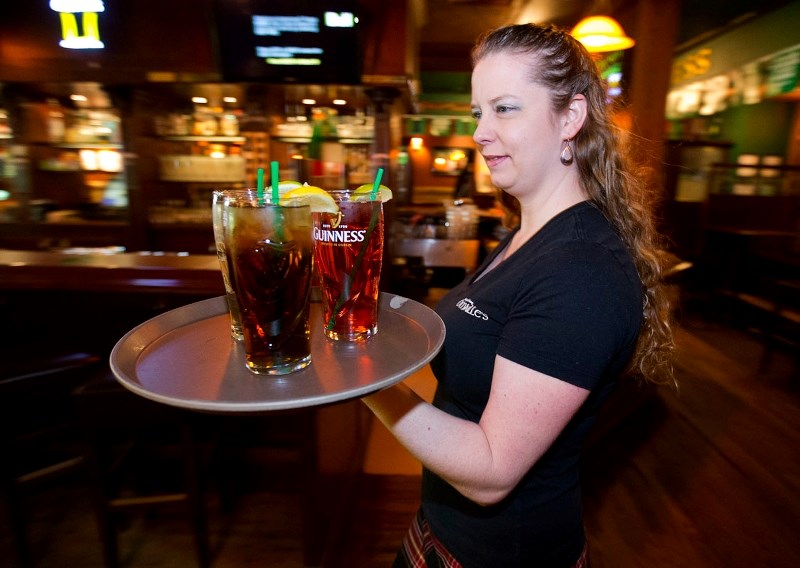I have a drinking problem.
Whenever I have to walk a drink from the fridge to the dinner table, I always have to take baby steps to keep it from spilling over the rim of the mug and splattering on the floor.
Which is why I'm quite envious of Shannon Bishop of O'Maille's Irish Pub in St. Albert.
"I haven't spilled a drink in probably 10 years," says the veteran bartender, and that's despite slinging tall glasses of beer most days at high speeds.
Her secret? "Practice!" she says, with a laugh.
And, as it turns out, physics.
Spilled drinks are actually of great interest to engineers, says Lorenz Sigurdson, retired professor of mechanical engineering at the University of Alberta and a specialist in fluid dynamics, as the forces in a sloshing mug are the same ones as those in a gas tank or tanker truck.
Unlike solids, liquids automatically deform when exposed to an external stress, Sigurdson says.
Say you have a cup of coffee in a car. Accelerate, and the cup wall pushes against the back of the liquid, causing it to pile up at the back of the cup. Hold a steady pace, and the force goes away and it levels out. Slam the brakes, and inertia carries the liquid forward and it splashes to the front of the cup.
"When you're walking along, the forces are all over the place," Sigurdson continues.
You're speeding up, slowing down, swaying and bouncing as you walk, and all these forces impact your drink at different angles. This causes your drink to slosh about unpredictably, and spill whenever the forces are big enough to throw the drink over the rim.
That's more likely to happen if those forces match the resonance frequency of the mug. If the force you put into your moving mug synchs up with when a slosh hits its peak, the slosh will get bigger.
"If you hit the resonant frequency of that slosh, then, man, it's really going to fly and hit you in the eye," Sigurdson says.
Mathematician Rouslan Krechetnikov (now at the U of A) decided to study the physics of spilled coffee back in 2012. He filmed himself at 100 frames per second while walking with a mug of coffee, analyzed the footage, and found that the frequency of his steps happened to come close enough to the resonance frequency of the mug (about 2.6 to 4.3 hertz) to trigger amplification and spillage.
Spill prevention
Science has many methods available to keep drinks safe.
Concentrating on your drink while walking lets you dynamically adjust the forces on it to prevent spills, Krechetnikov says in an email interview. Experienced drink carriers such as Bishop can do this so well that they can move quickly without spills.
Bishop notes that the faster you walk, the less your drink sloshes.
That's likely because fast steps put you less in sync with the resonance frequency of your drink, reducing amplification and splashes, Sigurdson says.
Krechetnikov says you can avoid spills if you carry your mug on a tray suspended from a carrier ring, as is often done in the Middle East. The tray acts as a pendulum that swings at a different frequency from your steps, buffering their effect on the drink.
Adding baffles to your cup (such as spoons) will create turbulence in the drink and convert its sloshing energy into heat, Sigurdson says. Switch to a tall, thin cup, and you'll raise the resonance frequency high enough that it no longer matches your steps.
You can also add foam. Engineers Alban Sauret and Emilie Dressaire published a paper in the journal Physics of Fluids last February that showed they could dampen most sloshes in a fluid with just 0.3 centimetres of foam, and all but stop sloshing with three centimetres.
Bubbles work because the friction of the bubbles against the container walls sucks away energy from the wave and dampens the slosh, Dressaire says in an email.
"The more foam you place on the liquid, the more damping you get."
It's definitely easier to avoid spilling a thick, foamy drink like a Guinness than a coffee, Bishop agrees.
"If you spill a Guinness, you might as well not be a server!"
Sigurdson suggests simply getting a mug with a lid on it.
I prefer to take a sip of my drink before I walk – better in my mouth than on the floor, after all.




